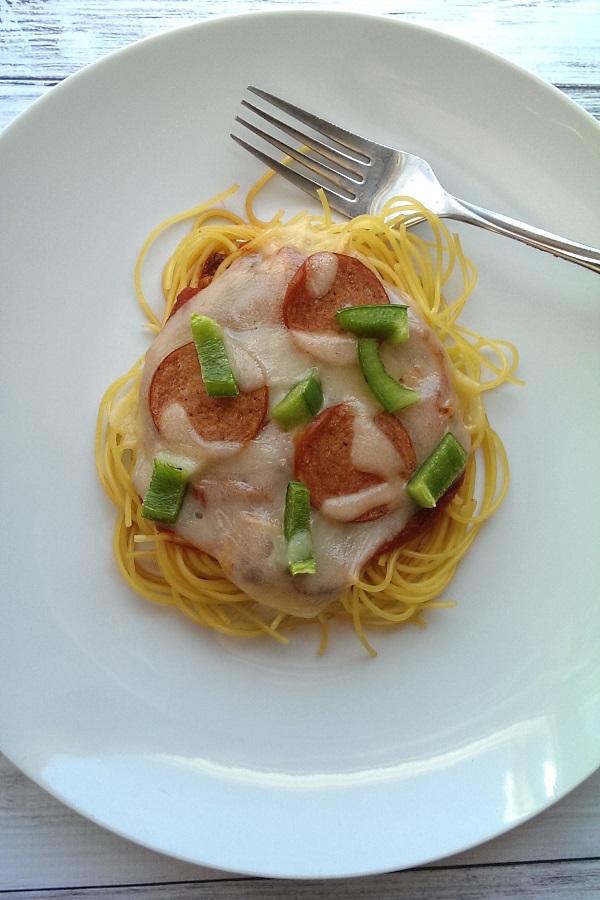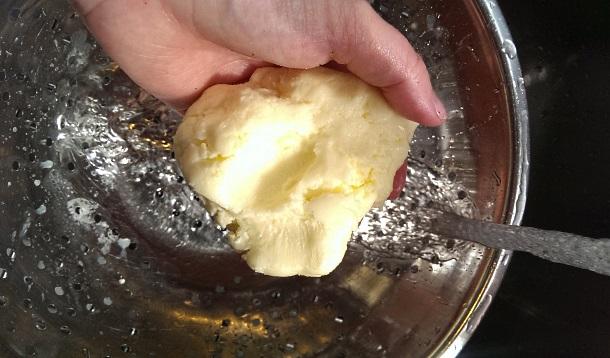
Have you ever wondered how to make whipped cream or butter? Most people take the two products for granted and it never crosses their minds about how it's made, except that it comes from dairy and maybe butter-making requires a churn like you've seen at the Cracker Barrel on some trip to Florida. Many people don't even realize that the biggest difference between whipped cream and butter is the amount of time you've spent making it.
![]() RELATED: How To Make An Easy Vegan Coconut Whipped Cream
RELATED: How To Make An Easy Vegan Coconut Whipped Cream
Why would you want to make butter, you might ask? Why would you not? Butter's the not-so-secret miracle food of the restaurant industry, baking, and southern cooking, which is how people like Paula Deen get mighty famous, y'all. And some people use a lot of butter. Also, it's a great science and history project for kids. It's like asking why you'd climb Everest. You have to make butter, if only once, just because you can.
Butter's an amazing food. From a scien-historical standpoint, butter (and its kin in cheese) are shelf-stable, preserved milk products that can sit without refrigeration. That's right. You don't have to let all your butter sit in the refrigerator, hard and cold. It's quite safe to leave a half a stick or so out on the counter in a butter dish for your daily toastmaking - as long as it's salted.
Salt, you see, is a natural preservative.
The pioneers had butter, man. You think they carried fridges in their covered wagons? NOPE. But they did have salt.
I digress. You're here to learn how to make butter. In fact, you might already have seen some homesteader 101's info on making butter with a stand mixer. But maybe you don't know why it works. Or whether you can make it without a stand mixer. Maybe you don't know that you make whipped cream practically the same way.

Milk is composed mostly of water, lactose (milk sugar), proteins, and fats. When you make cheese, cheese is an (eventual) product that starts with a chemical reaction that involves the proteins in milk. Butter and whipped cream, on the other hand, are all about the fat. Both are made from cream, and cream is the high-fat milk product that results when you let fresh milk (straight from the cow) sit until it separates. The less-dense fat molecules rise to the top, like ice in a glass.
The fats in cream that make butter are triglycerides. You can envision them like an egg sitting in water: they’re normally suspended in milk because the triglycerides are encapsulated by a thin shell made up of a bit of protein, cholesterol, and molecules called phospholipids. The phospholipids have a unique structure–a “head” that is hydrophilic (water-attracting) and a tail that is hydrophobic (water-repelling)–that causes it to form a triple-layer bond that keeps the triglycerides happily floating around in their little egg shapes, separate from the liquid water in milk and one another.
You can damage that phospholipid layer with brute force.
When you begin to whip cream that has a high enough fat content (ideally, about 35%), as when you whip anything, you're forcing air into the mixture. After a brief period of whipping, the few exposed triglycerides (which hate water and will refuse to mix with it) will begin to attach to each other, thickening the mixture. A little bit more whipping, and the hydrophobic triglycerides will begin to attach to air instead, holding it. After a period of a couple of minutes when you're using a mixer, you will have stiff peaks, and that's where you need to stop--if you're making whipped cream.
Do you have to have a mixer to make whipped cream? The answer is: nope! You can make whipped cream in a jar (especially nice, because it's self-contained). Pour your cream in, add a little sugar or vanilla if you want, seal the jar, and send the kids to go play maracas with it. When it stops sloshing around so much, open up the jar and check it out.

But whipped cream is a long way from butter, you argue. And sure, it looks that way.
![]() RELATED: The Simple Trick For Light and Fluffy Whipped Cream Every Time
RELATED: The Simple Trick For Light and Fluffy Whipped Cream Every Time
As you keep agitating the cream past the whipping cream stage (you'll want a mixer and not a jar for butter-making), the phospholipid layers are destroyed, exposing more and more of of the triglycerides, which continue to bond to each other in order to keep from mixing with liquid. The clumps of fat grow ever larger, squeezing out the air again, until suddenly you are left with solid lumps of the fats sitting in liquid--butter sitting in its own buttermilk.
PS - the last stage is a little messy, so I recommend using the splash guard.

With cold, clean hands, you can pack these fats together in a larger clump (and pour the buttermilk through a sieve to salvage it--it's good stuff!). Take the lump over to a bowl of ice water, or run it under the cold tap, and knead the butter tightly together into a firm lump. This "washing" process will squeeze the last of the buttermilk out, leaving you with very little liquid in the finished product (ideally, less than 20%).
The more liquid you can squeeze out of it, the better your butter is.
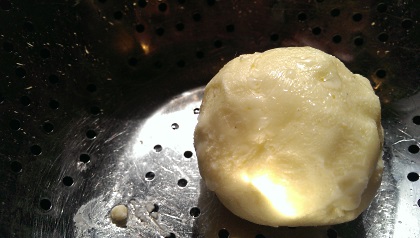
Once your butter is as dry as you can make it, you can knead salt into it and shape it into pats, if you have a butter press! Or if you want a special (southern) treat, whip room-temperature butter with some honey for a dinner-roll spread that your guests won't soon forget.
I recommend you keep your first attempts at homemade butter in the fridge or freezer when you're not using it, because your butter is likely to have a higher water content than commercially made butter (especially if it wasn't packed in a press) and probably not enough salt to render it shelf-stable for long enough to use it all up.
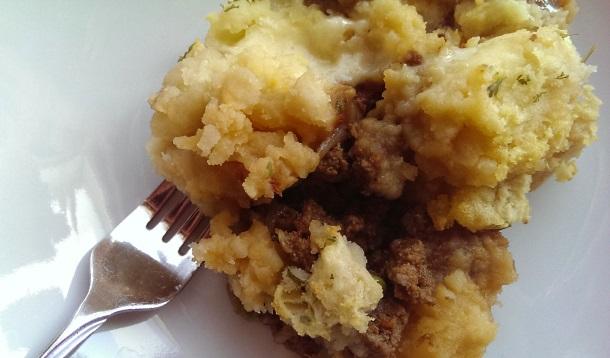
Great Britain has a message for all North Americans: Shepherds don't shepherd cows.
It's true. I once bore witness to a visiting British friend of mine's hilarious 30 minute gripe-capade on the subject over several beers at the local "Irish" pub called Sláinte (which he referred bitingly to as charmingly TGI-Irish... but with an acceptably-served Guinness draft). Incidentally, we learned that night that drinking beer does wonders for understanding ornery cockney.
Anyhow. Makes sense to me. Shepherds shepherd sheep. That'd be the whole "shep" part, I think. When questioned by the young waitress about what it should be called, he informed her that the beef kind is cottage pie. Then he proceeded to complain about how America ruined the Googling of shepherd's pie recipes by filling up the internet with millions of cottage pie recipes that have been falsely labeled.
I have to admit, he has a bit of a point. A proper shepherd's pie recipe made with lamb takes a bit of searching. Fortunately, many cottage pie recipes can be transformed into shepherd's pie by swapping out the beef for lamb.
![]() To-Die-For Greek-Style Lamb Burger Recipe
To-Die-For Greek-Style Lamb Burger Recipe
And now you know. Shepherd's pie made with beef is not a shepherd's pie.
Shepherd's pie is one of my favourite comfort foods, and like the best comfort foods, there is no such thing as 30 minutes or less. No, a good shepherd's pie is a big-on-flavour labour of love, best savored on slow days with friends and family. As we're heading into March break, you might find it a good time to invest a little in this dinner - it makes plenty of leftovers that freeze well and reheat well, and like many comfort food recipes, you can play around with the flavours a bit depending on your mood.
Because I love cheese, I discarded the traditional Parmesan in favour of a sharp white cheddar. In honour of St. Patrick's day, I grabbed a can of Guinness at the liquor store, because you can hardly have St. Patrick's day and Shepherd's Pie in one recipe without a nod to one of the great Irish beers.
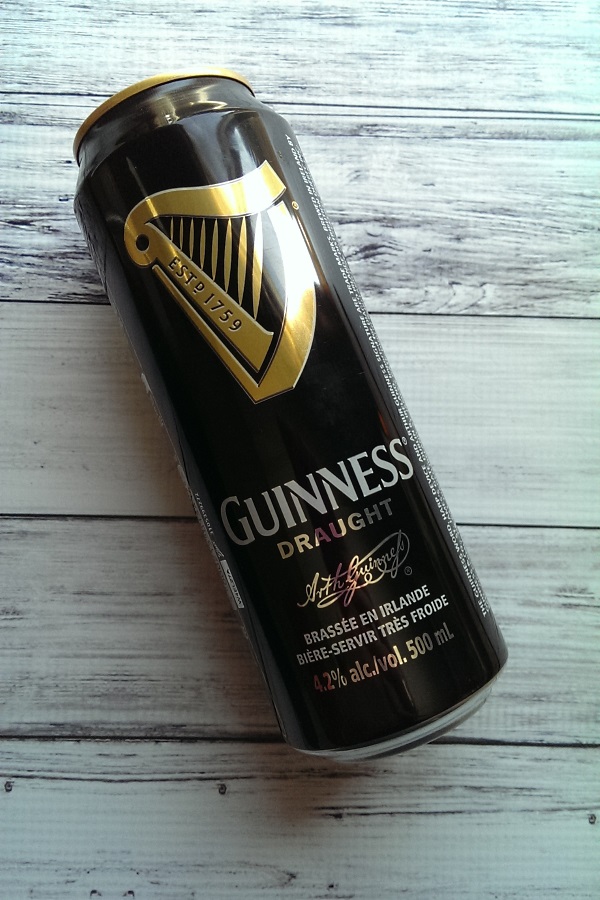
A lot of people find cooking with Guinness difficult, if not impossible. Drinking the beer is an acquired taste at best, and using a large quantity of the beer can impart a strong, bitter flavour that not all may find palatable - if you don't know how to work with it. Rather than throw sugar or honey or cream at it, which doesn't work very well and can change the flavour of the entire dish, a tiny bit of baking soda in the pot - just a scant 1/8 tsp - can balance the acidity and take most of the edge off the Guinness without making your dish sweet and weird.
Nicole taught me this trick for sweetening spaghetti sauce without added sugar, but I've been gleefully applying this trick to many bitter and acid dishes with huge success.
Gotta love better living through chemistry!

 In a large pot, brown the lamb in batches with a little bit of olive oil, seasoning it with a little salt and pepper. Drain the ground lamb thoroughly in a colander and set aside.
In a large pot, brown the lamb in batches with a little bit of olive oil, seasoning it with a little salt and pepper. Drain the ground lamb thoroughly in a colander and set aside.
 Add a little bit more olive oil to the pot and fry the onion and garlic with a bit of salt, until onions brown.
Add a little bit more olive oil to the pot and fry the onion and garlic with a bit of salt, until onions brown.
 Return the ground lamb to the pot and add the tomatoes, stirring it over medium-high heat for 3-4 minutes, until the tomatoes begin to break down. Add the Guinness, thyme, parsley, bay leaf and Worcestershire sauce. Bring to boil and cook down at a simmer, till liquid is halved.
Return the ground lamb to the pot and add the tomatoes, stirring it over medium-high heat for 3-4 minutes, until the tomatoes begin to break down. Add the Guinness, thyme, parsley, bay leaf and Worcestershire sauce. Bring to boil and cook down at a simmer, till liquid is halved.
 Add baking soda and stir thoroughly. Add the chicken stock, bring to a boil again, and let simmer for about 20 minutes, or until liquid has thickened to a shiny sauce. Fish out the bay leaf and add any frozen vegetables in the last few minutes.
Add baking soda and stir thoroughly. Add the chicken stock, bring to a boil again, and let simmer for about 20 minutes, or until liquid has thickened to a shiny sauce. Fish out the bay leaf and add any frozen vegetables in the last few minutes.
 Just after adding the chicken stock to the pot, set another pot of salted water to boil with the potatoes. Boil until fork-tender and drain, then return them to the pot to dry any remaining liquid.
Just after adding the chicken stock to the pot, set another pot of salted water to boil with the potatoes. Boil until fork-tender and drain, then return them to the pot to dry any remaining liquid.
 Start the oven preheating to 375F. Mash the potatoes well with the butter and egg yolk, until fluffy. Stir the chunks of white cheddar into the mashed potatoes to allow it to begin melting.
Start the oven preheating to 375F. Mash the potatoes well with the butter and egg yolk, until fluffy. Stir the chunks of white cheddar into the mashed potatoes to allow it to begin melting.
 Pour the ground lamb mixture into a large, 2L casserole dish, and top with the mashed potatoes. Rough it up with a fork, and bake at 375F for 25-30 minutes, or until bubbly. Turn on the broiler for a few minutes if you like to brown the potatoes.
Pour the ground lamb mixture into a large, 2L casserole dish, and top with the mashed potatoes. Rough it up with a fork, and bake at 375F for 25-30 minutes, or until bubbly. Turn on the broiler for a few minutes if you like to brown the potatoes.
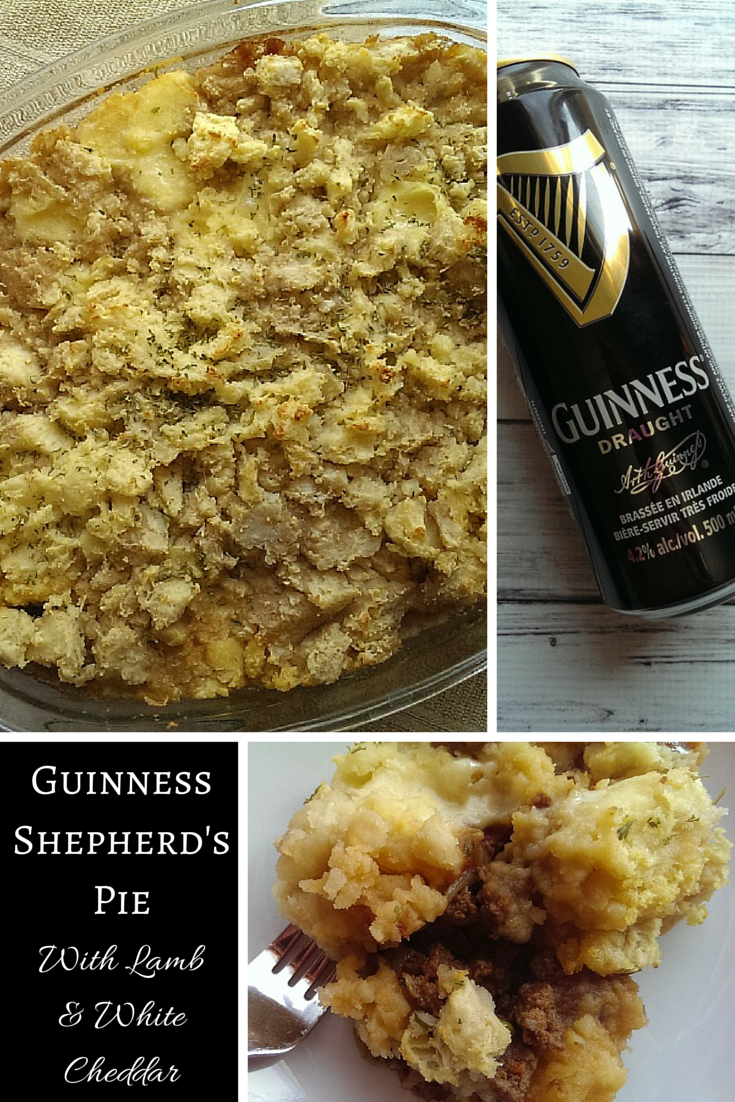

Kids are hilarious. When something becomes their favourite food, they can eat it a thousand times in a row. And then, sometimes, for no reason whatsoever, it becomes the "Hate Most in the Universe" thing.
Case in point: when I first introduced my two year-old to spaghetti and meat sauce, it was his favorite food. Ever. He called it "Psketti and-a Meat-a-balls." Since I loaded up the meat sauce with spinach and other green veg, I thought it was a win-win situation all around. Kidlet ate his weight in spaghetti over the next couple of years, and all was great.
![]() This Muffin-Sized Spaghetti Meal Is A Hit With Kids
This Muffin-Sized Spaghetti Meal Is A Hit With Kids
Until it wasn't.
I have no idea why he suddenly hated his favourite food, but the adult in me was secretly wondering why it took him so long to get to this point. Variety is the spice of life; etc. etc., cliche cliche. And yet, I couldn't avoid spaghetti forever; it's just too convenient to freeze tubs of prepared sauce for those evenings when you just NEED something ready to eat in about 15 minutes.
Spaghetti night was well overdue for an overhaul, and as any parent can tell you: sometimes perception is everything.
As an added bonus, this kid-friendly treat is also easy to make vegan/dairy-free (with alternative cheese), and gluten-free (using rice pasta)!
Ingredients
Spaghetti
Marinara sauce
Grated mozzarella cheese
Pizza toppings (peppers, onions, mushrooms, pepperoni, etc.)
 Cook the amount of spaghetti you normally prepare for your family until fully done (about 8-10 minutes).
Cook the amount of spaghetti you normally prepare for your family until fully done (about 8-10 minutes).
 Preheat the oven to 350F. Layer a piece of parchment over your cookie sheets for easier transfer later on.
Preheat the oven to 350F. Layer a piece of parchment over your cookie sheets for easier transfer later on.
 Drop scoopfulls of cooked spaghetti into flat, circular disks about 4-5 inches across to make the "crusts." Tuck in stray ends and make sure the spaghetti is piled about 1" thick to keep the toppings from dripping through.
Drop scoopfulls of cooked spaghetti into flat, circular disks about 4-5 inches across to make the "crusts." Tuck in stray ends and make sure the spaghetti is piled about 1" thick to keep the toppings from dripping through.
 Spoon marinara sauce over the top of the spaghetti crusts, and proceed to top them as desired. Set them in the oven to heat the toppings through and melt the cheese, about 5-8 minutes.
Spoon marinara sauce over the top of the spaghetti crusts, and proceed to top them as desired. Set them in the oven to heat the toppings through and melt the cheese, about 5-8 minutes.
 Carefully transfer the pizzas to the plate with a spatula and enjoy!
Carefully transfer the pizzas to the plate with a spatula and enjoy!
